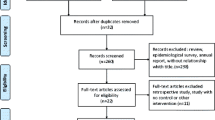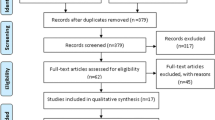Abstract
Systematic review (SR) of high-quality studies provides superior evidence, but an SR has not been conducted to evaluate the association between Keshan disease (KD) and selenium deficiency because SR was not available when KD was highly prevalent in the 1950s to 1970s. The objective of this study was to update our understanding of the etiology of KD and provide evidence for policies and strategies in KD surveillance, prevention, and control. We identified related studies by searching the CNKI, Wanfang, CQVIP, SinoMed, CMCI, PubMed, Embase, and EBSCO databases from January 1935 to April 2017. Community trials that met the inclusion criteria were included. Risk ratios (RR) with corresponding 95% confidence intervals (CI) were pooled to compare incidences between the two groups. A total of 17 articles (including 41 studies) were included. In total, the studies included 1,983,238 subjects, 683,075 of which were in experimental groups and 1,300,163 of which were in control groups. The protection rates were over 80% in 35 studies, and the overall effect (risk ratio) was 0.14 [95% CI (0.12, 0.16), P < 0.05]. Potential publication bias was observed in the funnel plots, but the results of Egger’s and Begg’s tests showed that there was no evidence of publication bias. Giving selenium supplements to the residents of KD endemic areas significantly reduced the incidence of KD. Selenium deficiency is therefore a cause of KD by the criterion of causation in modern epidemiology. Selenium should be included in the KD surveillance program. The description of “unknown cause” in the definition of KD may be inappropriate.





Similar content being viewed by others
References
The Ministry of Health of the People’s Republic of China (2011) The criteria for diagnosis of Keshan disease (WS/T 210–2011). National Standards of the People’s Republic of China. Beijing: Standards Press of China
The Ministry of Health of the People’s Republic of China. (1997) Diagnosis standard for Keshan disease(GB 17021–1997). National Standards of the People’s Republic of China. Beijing: Standards Press of China
Xu GL (1996) Research progress of prevention of Keshan disease by supplementation of selenium and the relationship between selenium deficiency and Keshan disease: commemorating the 60th anniversary of the discover of Keshan disease. Endemic Diseases Bulletin 11(2):1–6
The Central People’s Government of China (2016). General Office of the State Council. The National Endemic Disease Prevention and control plan (2011–2015) in China. http://www.gov.cn/zwgk/2012-01/29/content_2053487.htmChina (in Chinese)
Liu H, Yu F, Shao W, Ding D., Yu Z., Chen F., Geng D., Tan X., Lammi M.J., Guo X. (2017) Associations between selenium content in hair and Kashin-Beck disease/Keshan disease in children in northwestern China: a prospective cohort study. Biol Trace Elem Res https://doi.org/10.1007/s12011-017-1169-x
Zhou HH, Wang T (2015) Advance research on etiology of Keshan disease. Chinese J Endemiology 34(6):466–468
Cheng BR, Ju SJ, Yin ZH, et al. Selenium deficiency in the environment and Keshan disease (1987) In: Office of Endemic Disease Prevention and Control of the Central Committee of the Communist Party of China. Keshan Disease in China and the Research on Its Prevention and Control. Beijing: China Environmental Science Press:265–269 (in Chinese)
Tan JA, Zhu WY, Li RB. Medicinal and Geographical Characterization of Keshan Disease (1987) In: Office of Endemic Disease Prevention and Control of the central Committee of the Communist Party of China, ed. Keshan disease in China and the research on its prevention and control. Beijing: China environmental science press:254–264 (in Chinese)
Compiling Committee of The Atlas of Endemic Diseases and Their Environments in the People's Republic of China (1989). The atlas of endemic diseases and their environments in the People's Republic of China. Beijing: Science Press
Tan JA, Zhu WY, Li RB et al (1991) Association between Keshan disease and environmental selenium. Chinese Endemiology 10(5):269–274
Keshan Disease Research Group of the Chinese Academy of Medical Sciences (1974) Studies on the relationship of selenium and the incidence of Keshan disease. In: The National Collaboratory Group of Etiological Research for Keshan Disease National Symposium about Etiology of Keshan Disease in 1973:181–200
Yang GQ, Wang GY, Yin TA et al (1982) Relationship between Keshan disease distribution and selenium nutrition condition in China. Acta Nutrimenta Sinica 4(3):191–200
Keshan Disease Research Group of the Chinese Academy of Medical Sciences (1977) Determination of glutathione peroxidase in blood. In: the Chinese Academy of Medical Sciences, ed. research data on Keshan disease. Beijing:61–66 (in Chinese)
Xia YM, Zhu LZ (1987) Determination of glutathione peroxidase activity in blood and tissues. J Hygiene Res 16(4):29–33
World Health Organization (2015). International Statistical Classification of Disease and Related Health Problems 10th Revision. http://apps.who.int/classifications/icd10/browse/2016/en/
Keshan Disease Research Group of the Chinese Academy of Medical Sciences (1972) Effect observation on prevention of Keshan disease by using sodium selenite. Bulletin Medical Res 2:18–22
Keshan Disease Research Group of the Chinese Academy of Medical Sciences (1972) Continual observation on prevention of Keshan disease by using sodium selenite. Bulletin Medical Res 6:70–74
Anti-epidemic Station of Jilin city (1973) A summary of effect observation on prevention of Keshan disease by using sodium selenite. Bulletin Endemic Diseases (5):15–18 (in Chinese)
Manchikanti L (2008) Evidence-based medicine, systematic reviews, and guidelines in interventional pain management, part I: introduction and general considerations. Pain Physician 11(2):161–186
McKenzie JE, Salanti G, Lewis SC et al (2013) Meta-analysis and the Cochrane collaboration: 20 years of the Cochrane statistical methods group. Syst Rev 2:80
Li YH, Ghosh D (2014) Meta-analysis based on weighted ordered P-values for genomic data with heterogeneity. BMC Bioinformatics 15:226
Moher D, Tetzlaff J, Tricco AC et al (2007) Epidemiology and reporting characteristics of systematic reviews. PLoS Med 4(3):e78
Huang AJ, Zhan SY (2009) Systematic review and meta-analysis. Chinese J Drug Application Monitoring 6(4):257–259
Booth A, Clarke M, Ghersi D, Moher D, Petticrew M, Stewart L (2011) An international registry of systematic-review protocols. Lancet 377(9760):108–109
Panic N, Leoncini E, Belvis GD et al (2013) Evaluation of the endorsement of the preferred reporting items for systematic reviews and meta-analysis (PRISMA) statement on the quality of published systematic review and meta-analyses. PLoS One 8(12):e83138
Wei ML, Liu M, Su W et al (2007) The current status on systematic review/meta-analysis in Chinese publications from 1990-2007. West China Medical J 22(4):697–698
Lilienfeld AM (1957) Epidemiological methods and inferences in studies of non-infectious diseases. Public Health Rep 72(1):51–60
Moher D, Shamseer L, Clarke M et al (2015) Preferred reporting items for systematic review and meta-analysis protocols (PRISMA-P) 2015 statement. Syst Rev 4:1–9
Shamseer L, Moher D, Clarke L et al (2015) Preferred reporting items for systematic review and meta-analysis protocols (PRISMA-P) 2015: elaboration and explanation. BMJ 349:g7647
Moher D, Liberati A, Tetzlaff J, Altman DG, for the PRISMA Group (2009) Preferred reporting items for systematic reviews and meta-analyses: the PRISMA statement. BMJ 339:b2535
Research Laboratory of Keshan Disease in Xi’an Medical University (1973) A primary report on research of pathogenic factor in soil and water of Keshan disease. Bulletin Endemic Diseases (3):11–25
Collaboratory Group of Preventing Keshan Disease by Sodium Selenite (1975) A summary over the past 7 years on prevention of Keshan disease by using sodium selenite. J Hygiene Res 3:190–194
Collaboratory Group of Preventing Keshan Disease by Sodium Selenite (1976) Effect on prevention of Keshan disease by using sodium selenite in 1975. Bulletin Medical Res 5:29–32
Collaboratory Group of Preventing Keshan Disease by Sodium Selenite (1976) Effect on prevention of Keshan disease by using sodium selenite. Bulletin Endemic Diseases 3:15–19
Anti-epidemic Station of Jilin city (1977) Effect observation on prevention of acute Keshan disease by using sodium selenite. Chinese Journal Control of Endemic Disease (2):31–35
Research Laboratory of Keshan Disease in Xi’an Medical University (1978) Effect observation on prevention of acute Keshan disease by using sodium selenite. Shannxi Medical Journal (2):1–6 (in Chinese)
Anti-epidemic Station of Jilin city (1979) Effect observation on prevention of Keshan disease by using sodium selenite - a summary over the past 3 years in Jilin City from 1976 to 1978. Bulletin Endemic Diseases (2):29–33
National Collaboratory Group of Etiological Research for Keshan Disease: Task Force on Selenium (1979) Comprehensive report on prevention of Keshan disease by using sodium selenite. Bulletin Endemic Diseases 2:40–43
Research Laboratory of Keshan Disease in Xi’an Medical University (1979) Report on effect of acute Keshan disease prevention by using sodium selenite. Bulletin Endemic Diseases (2):1–5
Cao HC, Lou ZY, Qu FR et al (1982) Prevention of Keshan disease and influence of abnormal heart by using sodium selenite. Chinese J Endemiology 1(3):150–154
Yu DL, Zhou DZ, Yang PJ (1983) A summary over the past 7 years on prevention of Keshan disease by using sodium selenite. Chinese J Control Endemic Disease 1:41–42,73
Liu CD, Xu YC, Wang DQ (1988) The observation of relationship between trace element selenium and sub-acute Keshan disease onset. Chinese J Control Endemic Disease 4(2):93–94
Li GY, Wang TG (1992) Selenium and acclimation disease. Translations on Endemic Disease 13(5):1–6
Song HB, Xu GL, Yang YX et al (1992) Clinical evaluation on the association between selenium deficiency and Keshan disease. Shaanxi Medical Journal 21(10):589–592
Hopkins DR (2013) Disease eradication. NEJM 368:54–63
Toole MJ (2016) So close: remaining challenges to eradicating polio. BMC Med 14:1–4
Khanal S, Sedai TR, Choudary GR, Giri JN, Bohara R, Pant R, Gautam M, Sharapov UM, Goodson JL, Alexander J, Dabbagh A, Strebel P, Perry RT, Bah S, Abeysinghe N, Thapa A (2016) Progress toward measles elimination - Nepal, 2007–2014. MMWR Morb Mortal Wkly Rep 65:206–210
Newby G, Bennett A, Larson E, Cotter C, Shretta R, Phillips AA, Feachem RGA (2016) The path to eradication: a progress report on the malaria-eliminating countries. Lancet 387:1775–1784
Wang T (2012) The translational epidemiology of Keshan disease surveillance. Foreign Medical Sci(Section Medgeography) 33(3):143–147
Funding
This study was supported by grants from the National Natural Science Foundation of China (81202154, 81372938, and 81773368).
Author information
Authors and Affiliations
Contributions
Huihui Zhou was the principal investigator of this paper. Huihui Zhou and Tong Wang developed the hypothesis and study design and supervised this study. All authors contributed to the study concept and design, analysis, and interpretation of data and drafted or critically revised the manuscript for important intellectual content and/or data acquisition.
Corresponding author
Ethics declarations
Conflicts of Interest
The authors declare that they have no conflicts of interest.
Rights and permissions
About this article
Cite this article
Zhou, H., Wang, T., Li, Q. et al. Prevention of Keshan Disease by Selenium Supplementation: a Systematic Review and Meta-analysis. Biol Trace Elem Res 186, 98–105 (2018). https://doi.org/10.1007/s12011-018-1302-5
Received:
Accepted:
Published:
Issue Date:
DOI: https://doi.org/10.1007/s12011-018-1302-5




